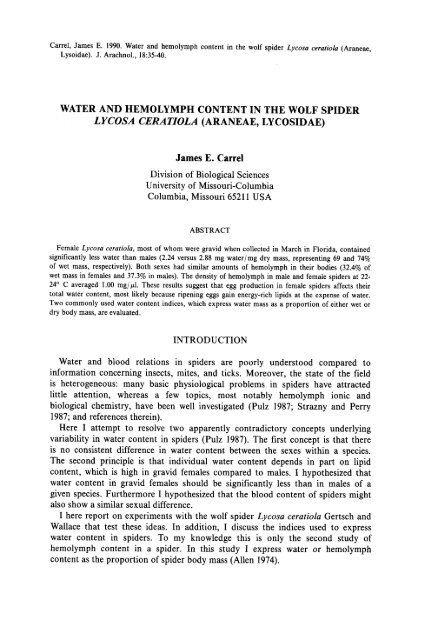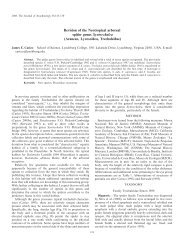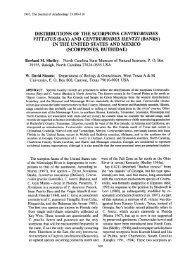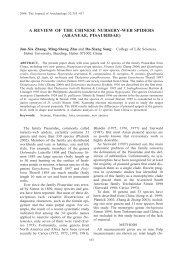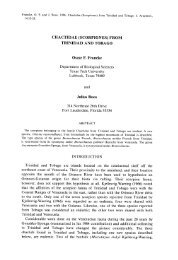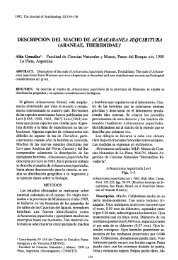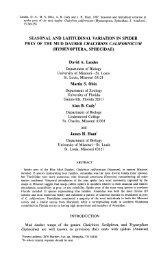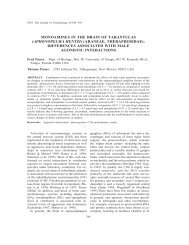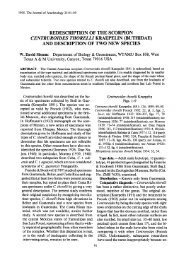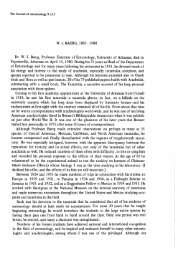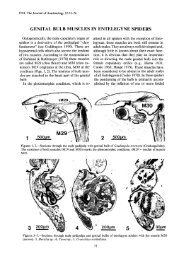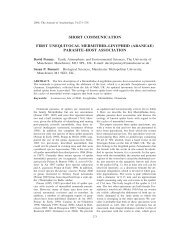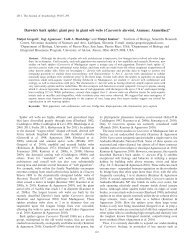WATER AND HEMOLYMPH CONTENT IN THE WOLF SPIDER ...
WATER AND HEMOLYMPH CONTENT IN THE WOLF SPIDER ...
WATER AND HEMOLYMPH CONTENT IN THE WOLF SPIDER ...
You also want an ePaper? Increase the reach of your titles
YUMPU automatically turns print PDFs into web optimized ePapers that Google loves.
Carrel, James E. 1990 . Water and hemolymph content in the wolf spider Lycosa ceratiola (Araneae,<br />
Lysoidae) . J . Arachnol., 18 :35- •40 .<br />
<strong>WATER</strong> <strong>AND</strong> <strong>HEMOLYMPH</strong> <strong>CONTENT</strong> <strong>IN</strong> <strong>THE</strong> <strong>WOLF</strong> <strong>SPIDER</strong><br />
LYCOSA CERATIOLA (ARANEAE, LYCOSIDAE)<br />
James E . Carrel<br />
Division of Biological Sciences<br />
University of Missouri-Columbia<br />
Columbia, Missouri 65211 USA<br />
ABSTRACT<br />
Female Lycosa ceratiola, most of whom were gravid when collected in March in Florida, contained<br />
significantly less water than males (2 .24 versus 2 .88 mg water/mg dry mass, representing 69 and 74%<br />
of wet mass, respectively). Both sexes had similar amounts of hemolymph in their bodies (32 .4% of<br />
wet mass in females and 37 .3% in males) . The density of hemolymph in male and female spiders at 22-<br />
24° C averaged 1 .00 mg/Al . These results suggest that egg production in female spiders affects their<br />
total water content, most likely because ripening eggs gain energy-rich lipids at the expense of water .<br />
Two commonly used water content indices, which express water mass as a proportion of either wet or<br />
dry body mass, are evaluated .<br />
<strong>IN</strong>TRODUCTION<br />
Water and blood relations in spiders are poorly understood compared to<br />
information concerning insects, mites, and ticks . Moreover, the state of the field<br />
is heterogeneous : many basic physiological problems in spiders have attracted<br />
little attention, whereas a few topics, most notably hemolymph ionic and<br />
biological chemistry, have been well investigated (Pulz 1987 ; Strazny and Perry<br />
1987 ; and references therein) .<br />
Here I attempt to resolve two apparently contradictory concepts underlying<br />
variability in water content in spiders (Pulz 1987) . The first concept is that there<br />
is no consistent difference in water content between the sexes within a species .<br />
The second principle is that individual water content depends in part on lipid<br />
content, which is high in gravid females compared to males . I hypothesized that<br />
water content in gravid females should be significantly less than in males of a<br />
given species . Furthermore I hypothesized that the blood content of spiders might<br />
also show a similar sexual difference .<br />
I here report on experiments with the wolf spider Lycosa ceratiola Gertsch and<br />
Wallace that test these ideas . In addition, I discuss the indices used to express<br />
water content in spiders . To my knowledge this is only the second study of<br />
hemolymph content in a spider. In this study I express water or hemolymph<br />
content as the proportion of spider body mass (Allen 1974) .
36 <strong>THE</strong> JOURNAL OF ARACHNOLOGY<br />
MATERIALS <strong>AND</strong> METHODS<br />
Adult male and female L. ceratiola (N = 148) were collected in March in xeric<br />
scrubby flatwoods at the Archbold Biological Station, Highlands County,<br />
Florida. At this time of year, as indicated by preliminary field surveys,<br />
reproduction is prevalent in this species (J . E . Carrel, unpublished observations) .<br />
Spiders were maintained individually in plastic containers as described by Carrel<br />
and Eisner (1984) . Their wet mass when alive was measured individually to the<br />
nearest 0 .1 mg shortly before being used in tests . Individual spiders were used<br />
only in one test .<br />
Water content of L. ceratiola was determined gravimetrically . Adult spiders<br />
(N = eight of each sex) were weighed, placed individually in a tared vial, killed by<br />
freezing, and then dried to constant mass in an 80° C oven . Water content was<br />
expressed as % wet mass and mg water/ mg dry mass .<br />
To calculate hemolymph content (% wet mass) I determined density and<br />
volume of hemolymph in spiders . Hemolymph density was measured in spiders<br />
(N = eight of each sex) as follows : individuals were anesthetized with carbon<br />
dioxide gas ; a leg was amputated at the base ; discharged hemolymph (2 .7-11 .1 µl)<br />
was taken up in a volumetrically calibrated tube previously weighed to 1 ug on a<br />
Cahn 28® electrobalance ; the filled tube was reweighed and the volume of fluid in<br />
it was measured . Density of each hemolymph sample was calculated by dividing<br />
its volume by its mass (mg/ µl) .<br />
Hemolymph volume in adults (N = eight of each sex) was determined using the<br />
radiolabeled inulin dilution method (Wharton et al . 1965) . Injection (5 /11) was<br />
accomplished with a micrometer syringe into the pericardial region of the<br />
abdomen of a spider anesthetized with carbon dioxide gas . Carboxy-14C-inulin<br />
(sp . act . 2 .60 mCi/gram, Sigma Chemical Co .) was dissolved in spider saline<br />
(Rathmayer 1965) to achieve a dosage of 0 .1 µCi per spider . Each spider was<br />
again anesthetized 1 h after injection and hemolymph was collected as previously<br />
described . The hemolymph was discharged immediately from the tube into 1 ml<br />
deionized water in a scintillation vial . Subsequently 15 ml of Aquasol scintillation<br />
fluid was added to each vial and radioactivity was measured in a Hewlett-<br />
Packard Tri-Carb 460C® scintillation counter . In a similar fashion the radioactivity<br />
in aliquots of the inulin stock solution was measured and used as a<br />
reference standard . To correct for counting inefficiencies and quenching effects,<br />
the sample channel ratio (SCR) was used to calculate total radioactivity (cpm) in<br />
each sample . Hemolymph volume of each spider was calculated as follows :<br />
Vb =<br />
V C G<br />
-V,<br />
where : Vb = volume of hemolymph in spider<br />
V S = volume of hemolymph sample<br />
V; = volume of solution injected (5 µl)<br />
C; = count of solution injected<br />
C S = count of hemolymph sample<br />
The reproductive state of female L . ceratiola (N = 100) was determined in two<br />
ways . Using the method of Riddle (1985), 50 spiders were killed by freezing and<br />
their abdomens were bisected . Specimens with an egg mass greater than one-sixth<br />
of the cross-sectional area of the abdomen were considered gravid . To verify this
CARREL-<strong>WATER</strong> <strong>AND</strong> <strong>HEMOLYMPH</strong> <strong>IN</strong> LYCOSA<br />
Table 1 .-Dry mass and water content in adult Lycosa ceratiola . Differences between values with<br />
the same letter in a column are significant (a = P < 0 .001 ; b = P < 0 .01) with t-test . Mean ± SE,<br />
(Range) .<br />
Water content<br />
Sex Dry mass mg % wet mass mg water/ mg dry mass N<br />
Male 80 .1 ± 8 .9 a 74 .0 ± 0 .9' 2 .88 f 0 .14" 8<br />
(48 .3 - 117 .2) (71 .3 - 78 .2) (2 .48 - 3 .58)<br />
Female 228 .2 ± 26 .4' 69 .0 ± 1 .1 b 2.24 t 0 .10b 8<br />
(157 .5 - 388 .4) (61 .5 - 71 .2) (1 .59 - 2 .47) -<br />
procedure, the remaining 50 spiders were inspected at 2-3 day intervals for 4 wk<br />
to ascertain whether each had produced an egg sac .<br />
Statistical analyses of the data were performed manually using the methods<br />
described in Sokal and Rohlf (1987) or by computer using SAS routines (SAS<br />
1985) .<br />
RESULTS <strong>AND</strong> DISCUSSION<br />
Living adult L. ceratiola exhibited a sexual size dimorphism . Data (X ± SE,<br />
N = 24 of each sex) showed female and male spiders weighed 724 ± 56 and 305 ±<br />
29 mg, respectively . This difference, a factor equal approximately to 2 .37, was<br />
highly significant (t-test, P < 0 .001) . Female spiders are larger than males,<br />
presumably because females invest much more in reproduction than males<br />
(Gertsch 1979 ; Foelix 1982.) . There was no significant difference (ANOVA, P ><br />
0 .01) in wet body mass among spiders used in different experiments.<br />
Female L. ceratiola contained proportionately more dry mass and, therefore,<br />
less water than males (Table 1) . By either index used in Table 1, water content in<br />
female spiders was significantly less than in males . The female/male dry mass<br />
ratio was 2.85, approximately 20% higher than the wet mass ratio .<br />
Whole body water content in L. ceratiola was slightly less than generally<br />
reported for adult spiders from a variety of biomes in North America (Stewart<br />
and Martin 1970 ; Vollmer and MacMahon 1974 ; Riddle 1985) . In all of these<br />
studies the spiders were well watered in the laboratory, so dehydration should not<br />
be a significant factor . Moreover, Vollmer and MacMahon (1974) found no<br />
correlation between habitat aridity, body mass, and interspecific differences in<br />
water content of spiders . Surely the relationship between water content and<br />
physiological ecology in spiders is sufficiently complex that many more data from<br />
many more species are needed to discern life history patterns .<br />
Density and relative amount of hemolymph was similar in male and female L .<br />
ceratiola (Table 2) . Females contained relatively less hemolymph than males, but<br />
because of the variability in the data, the difference between the sexes was not<br />
significant (t-test, P > 0 .05) . Whether the high degree of intrasexual variablity in<br />
hemolymph content is biologically meaningful or the result of an artifact remains<br />
to be determined .<br />
To my knowledge this is the first report of using dilution of radiolabeled inulin<br />
injected into spiders . Stewart and Martin (1970), using unlabeled inulin as a<br />
blood-born dye, reported the hemolymph in male and female Dugesiella hentzi<br />
37
38 <strong>THE</strong> JOURNAL OF ARACHNOLOGY<br />
Table 2 .-Hemolymph density and content in adult L. ceratiola. Differences between values in the<br />
same column are not significant (P > 0 .1) with t-test . Mean ± SE, (Range) .<br />
Sex Hemolymph density mg/µl Hemolymph content % wet mass<br />
Male 1 .003 f 0 .007 37.3 ± 2 .4<br />
(0 .97 - 1 .03 (28 .2 - 46 .9)<br />
Female 1 .000 t 0 .005 32 .4 t 6 .5 8<br />
(0 .98 - 1 .02 (26 .6 - 41 .6)<br />
averages 19 .65 and 18 .10%, respectively, of wet body mass . Although the<br />
hemolymph content in D. hentzi adults is about one-half as much as in L .<br />
ceratiola, a difference which in part could result from using different<br />
methodologies, nevertheless within each species females tend to have less<br />
hemolymph than males .<br />
A majority (74%) of 50 female L . ceratiola examined internally were found to<br />
be gravid . This method was verified by the finding that a smaller, but<br />
insignificantly different percentage (58%) of 50 females actually produced egg sacs<br />
when maintained for 4 wk in the laboratory (chi-square test, P > 0 .05) . Hence,<br />
lipid content of female spiders used in these water and blood content studies<br />
presumably was high because most of them contained energy rich eggs . The<br />
energy density of spider eggs, expressed as joules/g dry mass, generally is 11%<br />
higher than the average for nongravid adult spiders (Anderson 1978) .<br />
1 2 3 4 5 6 7<br />
mg water/mg dry mass<br />
10(mg water/mg wet mass)<br />
8 9<br />
Water mass (mg)<br />
Figure 1 .-Comparison of two indices for water content in a hypothetical spider having dry mass of<br />
1 mg as a function of its absolute water mass . (See text for details) . The range of water content values<br />
matches those actually found in various spiders under different conditions, as summarized by Pulz<br />
(1987). For graphical purposes, water content based on wet body mass is shown at one-tenth scale so<br />
that the two lines are similar in scope .
CARREL-<strong>WATER</strong> <strong>AND</strong> <strong>HEMOLYMPH</strong> <strong>IN</strong> LYCOSA 39<br />
As indicated in Table 1, the water content of whole spiders can be expressed by<br />
two different indices, one based on the wet mass and the other based on the dry<br />
mass of the animal . Most authors, as cited by Pulz (1987), have used the wet<br />
mass index, often refered to as "percent water" . But is one index scientifically<br />
more robust than the other? One way to answer this question is to examine how<br />
body water content changes as a function of water mass in a spider, under<br />
idealized conditions where dry mass is kept constant (say equal to 1 mg) as if the<br />
animal is undergoing dehydration or rehydration . As shown in Fig . 1, under these<br />
hypothetical conditions the two indices yield two rather different graphs : the wet<br />
mass index levels off asymptotically as the spider gains a lot of water, whereas<br />
the dry mass index rises in a linear fashion across the same range .<br />
From this graphical analysis, clearly the linear dry mass index is preferable to<br />
the curvilinear wet mass index of body water content . An example will illustrate<br />
this conclusion . At high moisture levels, a one percent gain or loss in water<br />
content based on a spider's wet body mass translates into a large change<br />
approximating 1 mg water/ mg dry mass of the animal .<br />
In conclusion, this study shows that a consistent difference in water content<br />
between the sexes of L. ceratiola can be found when females are gravid . The<br />
presence of eggs evidently increases the lipid and dry mass contents in female<br />
spiders, causing a slight (5%) decline in water content in comparison to male<br />
spiders .<br />
ACKNOWLEDGMENTS<br />
I thank Z . Yang and M . H . McCairel for field and laboratory assistance in<br />
preliminary studies, M . Deyrup and the staff of the Archbold Biological Station<br />
for hospitality and research facilities, J . D . David and G . H . Perrot for technical<br />
assistance, and J . F. Anderson and K . N . Prestwich for reviewing the manuscript .<br />
Supported in part by Research Incentive Funds from the University of Missouri-<br />
Columbia .<br />
LITERATURE CITED<br />
Allen, S . E ., ed . 1974 . Chemical Analysis of Ecological Materials . Wiley & Sons, New York .<br />
Anderson, J . F. 1978 . Energy content of spider eggs . Oecologia, 37 :41-57 .<br />
Carrel, J . E . and T. Eisner . 1984 . Spider sedation induced by defensive chemicals of milliped prey .<br />
Proc . Natl . Acad. Sci . USA, 81 :806-810 .<br />
Foelix, R . F. 1982 . Biology of Spiders. Harvard Univ . Press, Cambridge .<br />
Gertsch, W. J . 1979 . American Spiders, 2nd Ed . Van Nostrand Reinhold, New York .<br />
Pulz, R. 1987 . Thermal and water relations . Pp . 26-55, In Ecophysiology of Spiders (W. Nentwig, ed .) .<br />
Springer-Verlag, Berlin .<br />
Rathmayer, W. 1965 . Polyneuronale Innervation bei Spinnen . Naturwissenschaften, 52 :114 .<br />
Riddle, W. A . 1985 . Hemolymph osmoregulation in several myriapods and arachnids . Comp .<br />
Biochem . Physiol., 80A :313-323 .<br />
SAS . 1985 . SAS User's Guide : Statistics, Version 5 Edition . SAS Institute, Cary, North Carolina.<br />
Sokal, R. R . and F. J . Rohlf. 1987 . Introduction to Biostatistics, 2nd Ed . Freeman, New York .<br />
Stewart, D . M. and A . W. Martin . 1970 . Blood and fluid balance of the common tarantula, Dugesiella<br />
hentzi. Z . vergl. Physiol ., 70:223-246 .<br />
Strazny, F. and S . F. Perry. 1987 . Respiratory system : structure and function . Pp . 78-94, In<br />
Ecophysiology of Spiders (W. Nentwig, ed .) . Springer-Verlag, Berlin .
40 <strong>THE</strong> JOURNAL OF ARACHNOLOGY<br />
Vollmer, A . T. and J . A . MacMahon . 1974 . Comparative water relations of five species of spiders<br />
from different habitats . Comp. Biochem . Physiol ., 47A :753-765 .<br />
Wharton, D . R . A ., M . L. Wharton, and J . Lola . 1965 . Blood volume and water content of the male<br />
American cockroach, Periplaneta americana L.- methods and the influence of age and starvation .<br />
J . Ins. Physiol ., 11 :391-404 .<br />
Manuscript received May 1989, revised June 1989 .


